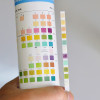.png)
 IJCP Editorial Team
IJCP Editorial Team
Comparative efficacy of ball squeezing and cartoon watching in pain management in children during IM injection
A recent study compared the effectiveness of ball squeezing and watching cartoons in managing pain during intramuscular (IM) injections in children.
This randomized controlled trial included children aged 6-12 years who visited the emergency department for IM injections. A power analysis was performed using the G*Power program; overall, 147 protocols were completed with children in the 6-12 age group, with 49 children in each group.
The results revealed that the Facial Pain Scale-Revised (FPS-R) scores during the procedure were the lowest in the group using the stress ball, and this difference was statistically significant. Similarly, the Visual Analog Scale (VAS) scores during the procedure were the lowest in the stress ball group, and the differences between the groups were statistically significant.
Therefore, both ball squeezing and watching cartoons were effective in reducing pain during IM injections; the group using the stress ball reported the lowest levels of pain. Among non-pharmacological methods, utilizing a stress ball for squeezing can be considered a practical and effective approach, particularly for pediatric nurses, to alleviate pain during IM injections in children.
Source: Bülbül F. , Özdemir S. The comparative effects of ball squeezing and cartoon watching in pain management in children during intramuscular injection: A randomized control trial. Mehmet Akif Ersoy Üniversitesi Sağlık Bilimleri Enstitüsü Dergisi. 2022; 10(3): 134-145.

IJCP Editorial Team
Comprising seasoned professionals and experts from the medical field, the IJCP editorial team is dedicated to delivering timely and accurate content and thriving to provide attention-grabbing information for the readers. What sets them apart are their diverse expertise, spanning academia, research, and clinical practice, and their dedication to upholding the highest standards of quality and integrity. With a wealth of experience and a commitment to excellence, the IJCP editorial team strives to provide valuable perspectives, the latest trends, and in-depth analyses across various medical domains, all in a way that keeps you interested and engaged.












Please login to comment on this article